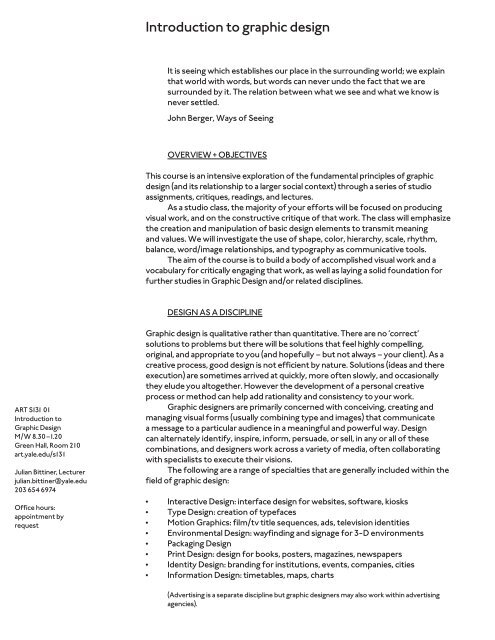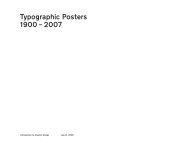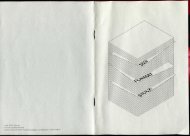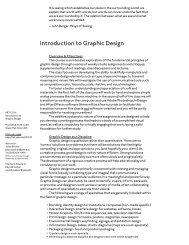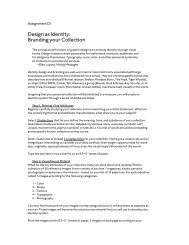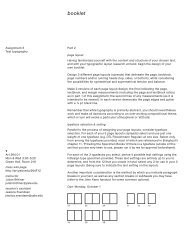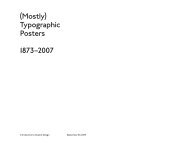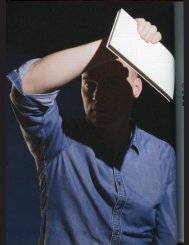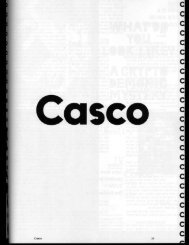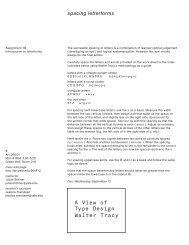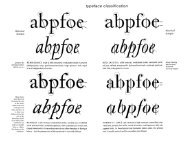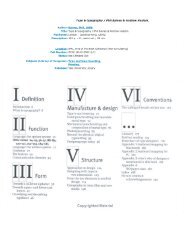Introduction to graphic design - Julian Bittiner
Introduction to graphic design - Julian Bittiner
Introduction to graphic design - Julian Bittiner
- No tags were found...
You also want an ePaper? Increase the reach of your titles
YUMPU automatically turns print PDFs into web optimized ePapers that Google loves.
<strong>Introduction</strong> <strong>to</strong> <strong>graphic</strong> <strong>design</strong>It is seeing which establishes our place in the surrounding world; we explainthat world with words, but words can never undo the fact that we aresurrounded by it. The relation between what we see and what we know isnever settled.John Berger, Ways of SeeingOverview + OBJECTIVESThis course is an intensive exploration of the fundamental principles of <strong>graphic</strong><strong>design</strong> (and its relationship <strong>to</strong> a larger social context) through a series of studioassignments, critiques, readings, and lectures.As a studio class, the majority of your efforts will be focused on producingvisual work, and on the constructive critique of that work. The class will emphasizethe creation and manipulation of basic <strong>design</strong> elements <strong>to</strong> transmit meaningand values. We will investigate the use of shape, color, hierarchy, scale, rhythm,balance, word/image relationships, and typography as communicative <strong>to</strong>ols.The aim of the course is <strong>to</strong> build a body of accomplished visual work and avocabulary for critically engaging that work, as well as laying a solid foundation forfurther studies in Graphic Design and/or related disciplines.Design as a DisciplineART S131 01<strong>Introduction</strong> <strong>to</strong>Graphic DesignM/W 8.30–1.20Green Hall, Room 210art.yale.edu/s131<strong>Julian</strong> <strong>Bittiner</strong>, Lecturerjulian.bittiner@yale.edu203 654 6974Office hours:appointment byrequestGraphic <strong>design</strong> is qualitative rather than quantitative. There are no ‘correct’solutions <strong>to</strong> problems but there will be solutions that feel highly compelling,original, and appropriate <strong>to</strong> you (and hopefully – but not always – your client). As acreative process, good <strong>design</strong> is not efficient by nature. Solutions (ideas and thereexecution) are sometimes arrived at quickly, more often slowly, and occasionallythey elude you al<strong>to</strong>gether. However the development of a personal creativeprocess or method can help add rationality and consistency <strong>to</strong> your work.Graphic <strong>design</strong>ers are primarily concerned with conceiving, creating andmanaging visual forms (usually combining type and images) that communicatea message <strong>to</strong> a particular audience in a meaningful and powerful way. Designcan alternately identify, inspire, inform, persuade, or sell, in any or all of thesecombinations, and <strong>design</strong>ers work across a variety of media, often collaboratingwith specialists <strong>to</strong> execute their visions.The following are a range of specialties that are generally included within thefield of <strong>graphic</strong> <strong>design</strong>:• Interactive Design: interface <strong>design</strong> for websites, software, kiosks• Type Design: creation of typefaces• Motion Graphics: film/tv title sequences, ads, television identities• Environmental Design: wayfinding and signage for 3-D environments• Packaging Design• Print Design: <strong>design</strong> for books, posters, magazines, newspapers• Identity Design: branding for institutions, events, companies, cities• Information Design: timetables, maps, charts(Advertising is a separate discipline but <strong>graphic</strong> <strong>design</strong>ers may also work within advertisingagencies).
Course OutlineThe course is divided roughly in<strong>to</strong> five sections: Design as Observation/Editing,Form, Visual Language, Identity, and <strong>design</strong> in Motion*.Design as Observation/Editing• Assignments A1,2: Collections• Introduc<strong>to</strong>ry Assignment: Abstract drawing• Readings: Norman Potter, Karel Martens, Bruno Munari, Paul EllimanDesign as Form• Assignments B1,2: Expressive Abstraction• Readings: Armin Hoffman, Ellen Lup<strong>to</strong>n, Mevis & van Deursen• Field trip: Yale Art Gallery – Print Study RoomDesign as Visual Language• Assignment C: Poster Remix• Informal Assignment: Typeface Research• Readings: Beatrice Warde, Phil Baines• Lecture: Typo<strong>graphic</strong> Posters 1900-2007• (Optional screening: Helvetica)• Provisional midterm grade: July 21Design as Identity• Assignments D1,2,3: Identity Design• Readings: Douglas Holt, John O’Reilly• Lecture: Identity Design Systems• Field trip: Yale Art Gallery Design Office*Design in Motion• Assignment E: Public Service Announcement• Final reviews: August 5 (group critique + final grade)*We will tackle this assignment time permitting.ATTENDANCEAttendance and punctuality <strong>to</strong> all classes and field trips is expected. Three latearrivals is equivalent <strong>to</strong> one unexcused absence. Each unexcused absence resultsin a one letter grade reduction of your final grade (e.g. A- becomes B-). More thantwo unexcused absences results in a failing grade.EvaluationYou will be assessed on the body of work you produce over the course ofthe class; understanding and demonstration of concepts presented in class;thoughtful and original responses <strong>to</strong> assignments; effectiveness and depthof process; active participation in critiques and discussions; care in craft andpresentation.Grades will be weighted 80% on assignments and process, 20% on classparticipation.


